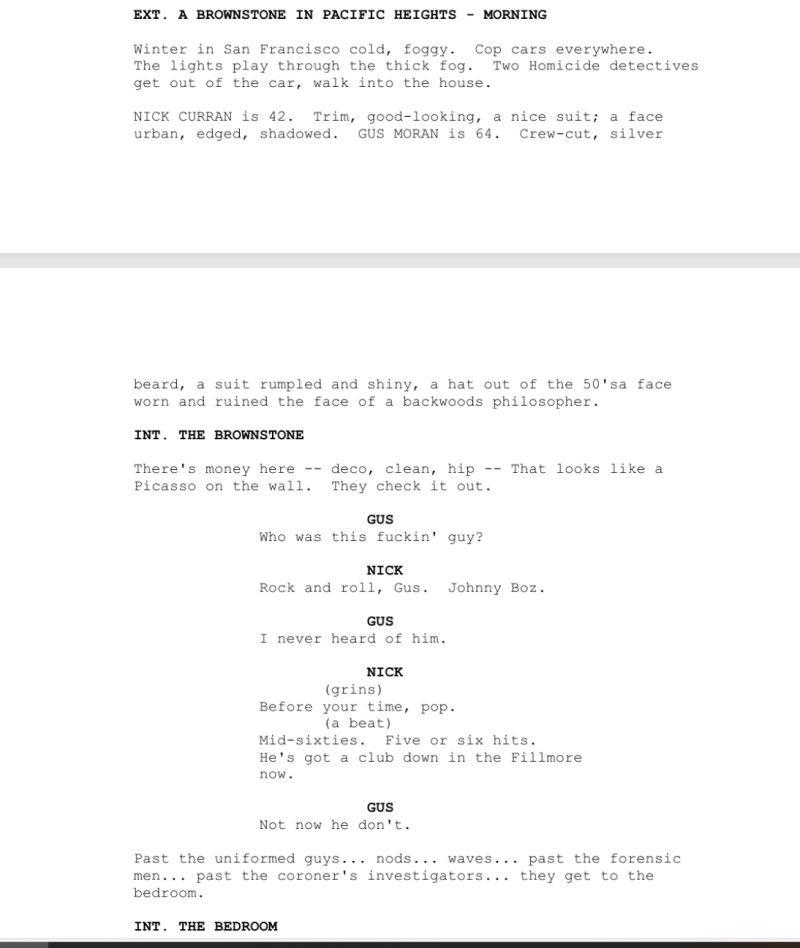

Translating Visions
Learning from BASIC INSTINCT
January 6th, 2025
At one time or another, all of us, have been told by those wiser that we should “write visually” as screenwriters.
It’s good advice and frankly no self-respecting screenwriter should ever stop thinking visually.
But, what exactly does it mean?
I have seen some inexperienced screenwriters take this instruction to heart and after reviewing some of the online screenplays (production drafts) they being to infiltrate their writing with camera angles: POV, CLOSE-UP, ect.
This, alas, is not what is meant by “writing visually.” It’s really more about “thinking visually.”
Every scene should be thought out by the screenwriter before it is written. You should be able to “see” the scene in your mind. Where it takes place, who’s in it, what’s in it, and how these things interact.
But from here I’ve seen inexperienced writers take this too much to heart and litter their prose with needless exposition and details that only serve to slow the story down.
It’s really more about “thinking visually.”
Remember, ultimately you have to use words to express what you’re seeing in your own mind. The reader is only going to “see” your scene proportionate to the ability of your writing (descriptions, exposition).
Use as few words as possible, use descriptive words and words of action.
 So remember to think visually, but be ready to master the art of translating those thoughts into words as ultimately that is your medium of communication to the reader. Use as few words as possible, use descriptive words and words of action (avoid using words that end in “ing”).
So remember to think visually, but be ready to master the art of translating those thoughts into words as ultimately that is your medium of communication to the reader. Use as few words as possible, use descriptive words and words of action (avoid using words that end in “ing”).
Be ready to master the art of translating those thoughts into words as ultimately that is your medium of communication to the reader.
Whenever I need to show my students an example of some good visual writing, I show them the opening scenes from Joe Eszterhas screenplay BASIC INSTINCT. (I can't believe this movie is now over 30 years old!)
Note how few words are needed to create a very visual scene. Eszterhas has a unique style that also shines through and adds some dimension to the writing.
His prose here is excellent and a fine example for how to do it:
(Originally posted in 2010)
About the Author
Take Chris' Class: Writing Screenplays Hollywood Wants. 12 tutorials, downloads, materials, 1.5 hours of video instruction, and a weekly interactive video Q & A. All for just $19.95!
(Follow on Twitter) Christopher Wehner is a published author and produced screenwriter, EL CAMINO CHRISTMAS @Netflix and AMERICAN DREAMER (later this year); visit his IMDB page for future projects. Christopher has been a leading member of the online screenwriter's community going back to the 1990s. In 2001 he published the groundbreaking book Screenwriting on the Internet: Researching, Writing and Selling Your Script on the Web,.
To contact Chris visit his website: Warm Beer Productions.
Only logged-in members can comment. You can log in or join today for free!
No comments posted.
Advertisement



















